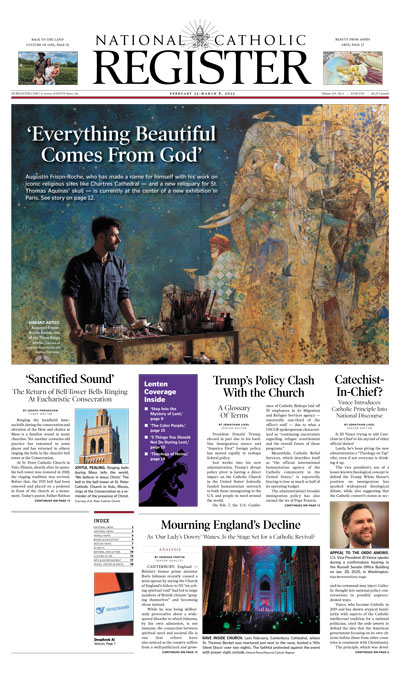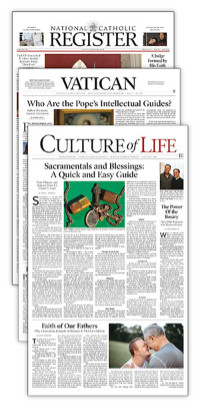‘Lumen Gentium’: A Bright Light for Theology in Our Time
COMMENTARY: The dogmatic constitution on the Church, released 60 years ago, is notable not only for what it taught, but how it taught it.

Lumen Gentium (The Light of Nations), the Vatican II constitution on the Church, marks its 60th anniversary Nov. 21.
As a “dogmatic constitution” of an ecumenical council, it is officially one of the most important magisterial texts of the last century. It also remains a high-water mark for theology in our time.
Nothing in the Church is ever entirely new. Lumen Gentium built upon the theological reflections on the Church during the 19th century, the teaching of Vatican I and Pope Pius XII’s 1943 encyclical, Mystici Corporis Christi, on the mystical body of Christ. Nevertheless, Lumen Gentium marked a different style of theological writing, nourished more directly by Sacred Scripture and expressed in a more beautiful literary style. The document was important not only for what it taught, but how it taught it.
Over the course of this year, Opus Dei Father Joseph Thomas provided an overview of Lumen Gentium’s teaching for the Register.
“With this solemn document, the Church sought to respond to a key question that the Council Fathers wanted to answer,” Father Thomas wrote. “What does the Church have to say about herself?”
What the Church thinks about herself is called “ecclesiology,” the branch of theology that deals with the nature and mission of the Church.
In 1962, as the Council opened, the bishops were presented with a draft text, De Ecclesia (On the Church). It was found lacking — and not only by so-called “progressives.” Blessed Stefan Wyszyński, primate of Poland, considered it too shallow.
“Cardinal Giovanni Battista Montini, archbishop of Milan and the future Pope Paul VI, expressed his opinion that while the existing text presented the truths of ecclesiastical law, it needed to give more attention to the mystery of the Church and, in particular, to the intimate relationship between the Church and Jesus Christ,” wrote Father Thomas. “The Council needed to show clearly, the cardinal noted, that the Church receives everything from Jesus Christ and can act only through Christ’s presence and action.”
The future St. Paul VI wanted a shift from the law of the Church to the love of God in Jesus Christ.
The revisions of the text followed in that vein. The initial first chapter was entitled “On the Nature of the Militant Church.” The final version was called “The Mystery of the Church,” and began with a proclamation about Christ himself, not the Church: “Christ is the Light of nations” and the purpose of the Church is “to bring the light of Christ to all.”
In the re-drafting of Lumen Gentium there was a shift toward theology that explicitly began with Scripture, and returned to the insights of the patristic period. It was a return to the theology of the early Christian centuries, before important questions of structure, law and the relationship with the state came to the fore.
George Weigel, in his 2022 book To Sanctify the World: The Vital Legacy of Vatican II, wrote how ecclesiology had been put “into a defensive crouch” by the “two-edged assault on Catholicism by Enlightenment rationalism and political modernity.”
“Reflecting Catholicism’s long post-Constantinian entanglement with state power, this Roman theology typically presented the Church in essentially juridical and legal terms,” wrote Weigel. “The Catholic Church was the societas perfecta, the ‘perfect society,’ self-contained and self-governing, and adherence to it was defined by obedience to the perfect society’s laws. In this perspective, the theology of the Church was the stepchild of canon law.”
If ecclesiology had become the stepchild of canon law, Lumen Gentium sought to restore it to full sonship — and if a son, then also an heir — in the world of biblical theology. And also literature, not the language of law.
Thus, for example, instead of a delineation of Church-state relations, Lumen Gentium gives a beautiful description of how the Church exists in the world, drawing upon the Gospels, the Psalms, Isaiah and Revelation.
“Since the kingdom of Christ is not of this world, the Church or people of God in establishing that kingdom takes nothing away from the temporal welfare of any people,” Lumen Gentium teaches (13).
“On the contrary it fosters and takes to itself, insofar as they are good, the ability, riches and customs in which the genius of each people expresses itself. Taking them to itself it purifies, strengthens, elevates and ennobles them. The Church in this is mindful that she must bring together the nations for that king to whom they were given as an inheritance, and to whose city they bring gifts and offerings. … The Catholic Church strives constantly to bring all humanity and all its possessions back to its source in Christ, with Him as its head and united in His Spirit.”
At the distance of 60 years, such beautiful Christocentric passages, while inspiring, no longer surprise. The magisterium of St. John Paul the Great and Pope Benedict XVI, both of whom attended Vatican II, has a similar feel — especially that of Benedict, whose works had an unusually high literary quality. It was Lumen Gentium that set that trajectory, exemplified also the next year with the dogmatic constitution on divine Revelation, Dei Verbum (1965).
The first major documents of the post-conciliar popes demonstrate this. Rather than treating the perennial Church-state question, as had been the custom, John Paul wrote of the “Redeemer of Man” (1979), Benedict wrote that “God Is Love” (2005) and Francis wrote of “The Joy of the Gospel” (2013).
The biblical and literary approach of Lumen Gentium shaped the most important post-conciliar text, the Catechism of the Catholic Church, which Cardinal Joseph Ratzinger praised for being beautiful, not merely authoritative, and gave the high praise — especially for him — of likening it to a symphony.
After 60 years, the music of Lumen Gentium resounds still.
- Keywords:
- lumen gentium
- vatican ii















